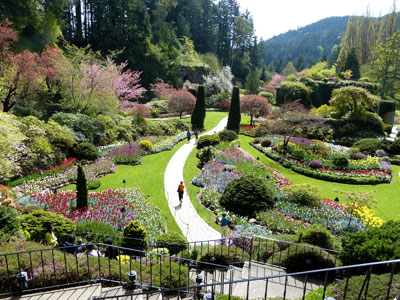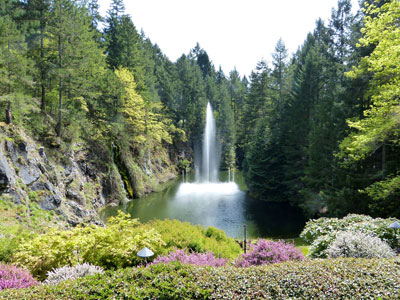The Butchart Gardens
This item appears on page 59 of the March 2014 issue.
Tulips, tulips and more tulips were the undisputed stars of The Butchart Gardens this day in mid-April 2013 on Vancouver Island, Canada. Tulips edged beds, outlined paths and admired their reflections in ponds, thanks to the importation of 300,000 bulbs from Holland each year.
Along with tulips galore, a bevy of other bulbs, plants, trees and shrubs were in full spring fling throughout The Gardens’ 55 acres.
Hyacinths, narcissus, pansies and primulas, froths of forget-me-nots and carpets of blue muscari were well represented, with the Weekly Flower and Foliage Report, offered to visitors as a handout, noting that more than two dozen varieties of shrubs and trees were also at the peak of colorful display.
Had it been summer, roses, with some 6,600 planted, would have been the star. Fall? Dahlias become the showoffs, while granting the Japanese Garden center stage with its parade of red, russet and golden maples joined by dozens of varieties of chrysanthemums.
The Butchart Gardens’ goal is that, no matter how often or when one chooses to visit, there will always be something fresh, new and different to see.
Envisioned more
As I wandered the paths of this gloriously flowering Eden, it was hard to believe that its historical roots had sprung from cement.
Robert Pim Butchart, a turn-of-the-20th-century pioneer in the burgeoning North American cement industry, was attracted to the west coast of Canada by its rich limestone deposits, vital for cement production. He chose Tod Inlet on Vancouver Island as the location for a factory. There, he and his family established their home.
Quite soon, the limestone in a quarry near the house became exhausted. What to do with the bleak pit? Robert’s wife, Jennie, had an idea.
From a nearby farm, she requisitioned tons of topsoil and had it taken to Tod Inlet by horse and cart to line the floor of the abandoned quarry. Little by little, under her supervision, the quarry blossomed into what is today The Gardens’ centerpiece, the spectacular and much-photographed Sunken Garden.
Other gardens followed, some reflecting the Butcharts’ world travels. In 1908, the Japanese Garden, on the sea side of their home, was established. Later, when Jennie took notice that the tennis court was not seeing much action, the Italian Garden took over its space. In 1929, the Rose Garden replaced the Kitchen Garden.
Word of Jennie Butchart’s gardens quickly spread. By the 1920s, more than 50,000 people were arriving each year to stroll the property. With that, the Butcharts’ christened their estate “Benvenuto” (“Welcome”) and planted an avenue of 566 flowering cherry trees — in glorious bloom at the time of my visit — along the road leading to the entrance gate.
Features of The Gardens
Once inside the garden gates, I followed signposts bristling with directions, as do today’s some one million annual visitors. They pointed the way to the major horticultural areas — Sunken Garden, Italian Garden, Japanese Garden, Rose Garden — as well as to restaurants and a museum, gift store, greenhouse and visitors’ center.
The Gardens has been in family ownership for over a century, with each succeeding generation remaining true to Jennie’s and Robert’s spirit of benvenuto while dedicating itself to restoration and improvement.
In 1954, summer evening concerts, from jazz to classical, were introduced, and they continue to entice thousands to spread out blankets and picnic on the Concert Lawn. Spectacular fireworks, introduced in 1978, enlist oohs and ahhs from throngs drawn to the fireworks viewing area on summer Saturdays.
The Gardens’ current owner and managing director is Jennie’s and Robert’s great-granddaughter, Robin-Lee Clarke. In 2009, under her direction, a Children’s Pavilion and carousel were constructed, the pavilion’s roof planted with native plant species. The traditional carousel housed within the pavilion consists of 30 hand-carved animals, a menagerie chosen by Clarke to mirror the world from which The Gardens draws its visitors.
Under Robin-Lee Clarke’s leadership, in 2004, marking the 100-year anniversary of Jennie’s and Robert’s arrival at Tod Inlet, The Gardens was recognized as a National Historic Site of Canada.
Proficiently run
As The Gardens approaches its near-century mark, dazzling display beds of flowering plants remain its chief drawing card. Fifty full-time gardeners, and an additional 12 part-time, keep the sweeping beds in pristine order, with 26 greenhouses covering one acre providing the horticultural wherewithal.
Plants are left unlabelled throughout the estate, preserving the ambiance of a private pleasure garden. Those wanting to know “What’s that?” can leaf through the “Flower & Plant Guide” provided to each visitor, picturing plants either commonly used in The Gardens or those attracting the most attention.
Should the plant in question not be listed, the guide suggests snapping a digital photo and stopping by the Plant Identification Counter in the Visitor Information Centre.
I didn’t think of taking a camera shot but stopped by the counter to ask what the drift of red, spiky blooms just outside the Japanese Garden entrance might be. With no hesitation, the woman jotted down the name of the plant in question, “Euphorbia fireglow,” and produced a picture for my verification.
While walking through the Sunken Garden, I spotted the tall chimney of a long-abandoned kiln, the sole, primary reminder of the horticultural wonderland’s cement roots. Sharp-eyed viewers, however, will spot whimsical reminders: handrails and arbors made of molded concrete, dead ringers for recycled tree branches.
Planning a visit
Located on Vancouver Island, off of western Canada, The Butchart Gardens (800 Benvenuto Ave., Brentwood Bay, Vancouver Island; 866/652-4422 or 250/652-5256) is situated 14 miles north of Victoria.
The Gardens is open daily at 9 a.m., with Christmas Day the sole exception, when it opens at 1 p.m. Closing hours vary greatly, depending on the month and date (from 3:30 in November to as late as 10 p.m. most of summer); be sure to check.
Admission rates vary according to season. The highest rates, from June 15 to Sept. 30, are CAD30.80 (near $28), adult; CAD15.40, youth (13-17), and CAD3, child (5-12). The Butchart Gardens hosted my garden visit.
My overnight stay in nearby Victoria was arranged for and paid by Tourism Victoria (812 Wharf St., Victoria, BC, Canada; 800/663-3883 or 250/953-2033).
I headquartered my visit at the Inn at Laurel Point (680 Montreal St., Victoria; 800/663-7667), which offers 135 rooms and 65 suites. Prices vary greatly, according to room size and location, but begin at approximately $120 per night for a double room and escalate from there.
The location of the inn was ideal. Two means of transportation to The Butchart Gardens were but a short stroll away. A regularly scheduled shuttle bus departed from the nearby Fairmont Empress hotel. Including admission to The Gardens, the round-trip cost was CAD54.25, adult. Or one can take, as I did for CAD1.50 each way, public bus No. 75, departing near the same location.
The inn was singularly appropriate for my “The Garden Path” stay, as not only is it one of Canada’s “greenest” hotels but its entire length is edged by an exquisitely kept Japanese garden constructed so that, to the eye, it merges seamlessly into the sea.


